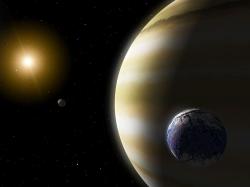
Artist's conception of planets around another star; credit: NASA/JPL
Extrasolar planets are planets around stars other than our own Sun. As of March 2007, 202 extrasolar planets have been detected. All of them are larger than the Earth — most are thousands of times more massive — but although they orbit some of the nearest stars to the Sun, they are nevertheless too far away and too small to be discovered in pictures. Instead, all of them were discovered in one of three ways: (1) by measuring the wobble in the star’s motion as the planet orbits around the star; (2) if the orbit fortuitously crosses our line-of-sight to the star, by spotting the faint dimming of the star’s light as the planet passes between it and the view from Earth; or (3), when a star and its planet are fortuitously reimaged by a gravitational lens (a star nearer to Earth whose gravity bends light like a lens — see Chapter 3) — by finding a characteristic spike in the star’s re-imaged light as the lensing star moves through space (only three examples of this so far).
There is every reason to think that Earth-sized planets will be found before long, as new instruments become more and more capable of discovering smaller planets. If an Earth-like planet orbits its star at a safe and comfortable distance where water can be liquid rather than frozen or gaseous (the “habitable zone”), perhaps in time life can form on it. Perhaps that life can evolve and become intelligent. Perhaps we are not alone in the Universe.
The implications for religious believers need not be threatening. Many theologians have accepted that an omnipotent God could have created more than one world; in 1277, the Bishop of Paris, Étienne Tempier, declared just that. In his commentary to the biblical Song of Deborah (Judges 5:23), the medieval commentator Rashi remarks that the inhabitants of a place named in the Song, “Meroz,” actually live around another star.
Let There Be Light, Chapter 6, talks about the Anthropic Principle (the amazing, contingent circumstances that make life possible), and revisits the idea in Chapter 8 in the context of intelligent life on Earth. My opinion is that, despite the increasingly long list of extrasolar planets, we will not know for a very long time, if ever, whether intelligent life exists elsewhere in the Universe. It is rare at best. Nevertheless there is no convincing reason why the human task of tikkun olam, repairing the world by good deeds, could not be seen as a goal for all intelligent beings, everywhere.